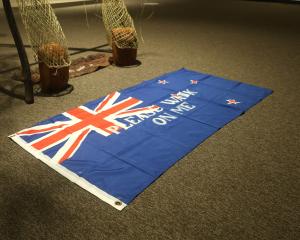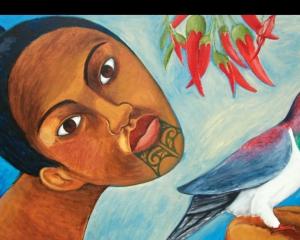
Dunedin street art, Central City
The recent fine weather in Dunedin has allowed the opportunity to explore some of the recent additions to Dunedin's street art.
Dunedin is slowly gaining a reputation for its murals, and several parts of the city have been significantly brightened by their presence.
The best known is arguably Belgian artist ROA's excellent ouroboros tuatara in Bank St, painted last summer.
Though far from Dunedin's first piece of street art, its central location prompted much talk and spurred suggestions for more such works around the city.
The result of this interest was Dunedin's first street art festival late last year, which saw several impressive murals go up, mostly around the exchange.
Pixel Pancho, DALeast, and Be Free were among the pseudonymous artists taking part, as was British artist Phlegm, whose massive work in Manse St is a star attraction.
Phlegm's wistful, if sinister, keyboardist pumps out a kaleidoscope of birds across the city.
The work owes much to graffiti tropes, but also hearkens back to the gentle surrealism of artists such as Remedios Varo.
Nearby is another fine piece.
Pixel Pancho's mechanical horse and rider fit their location at the corner of Princes and Jetty Sts perfectly and provide a marvellous image for those travelling south through the city.

Dunedin street art, Vogel St Precinct
Murals provide many challenges. There is the sheer scale of the work, often accompanied by a need for it to fit an oddly shaped space.
The mural must blend in, and not detract from the beauty of the buildings (even a run-down warehouse can have charm).
Permission of the property owner is also a component, often one that marks a boundary between street art and vandalism.
Vogel St has become the city's street art hub.
This renovated section of warehouse district now boasts several excellent works: Phlegm is again to the fore with his intriguing giant fish, Drypnz' Technicolor homunculus adds a splash of colour to a garage door, and even the street's seating is either sculpted or attractively augmented with paint.
The demands of odd-shaped spaces are shown by two works by Andy McCready and Sam Ovens.
These artists have taken the media, and especially Dunedin's music scene, as inspiration in their montages.
The street's newest work is the most riotous, a collaboration by several artists overlooking the Vogel St car park.
Ideas tumble over each other in this kaleidoscope of image and message.
The street's Queen's Gardens end is home to a more traditional work, a massive portrait by Dunedin's Jon Thom.
Better know for his charcoal and paper studies, this work effectively and attractively dominates the streetscape.

Dunedin street art, South Dunedin
Not everyone is convinced about street murals, connotations of vandalism not far from some people's minds.
But they have a long , impressive history, and many master artists, from Diego Rivera to Thomas Hart Benton, have created public street art.
More recently, graffiti has blossomed into a wealth of vibrant or politically motivated works, the latter best exemplified by the superstardom of Banksy.
Cities from Belfast to Melbourne are now famous for their murals.
Earlier Dunedin street art shows links with its graffiti origins.
One of Dunedin's older works - and probably the biggest - is the massive mural along Wilkie Rd's railway embankment, painted by Dunedin's Truest Crew in 2006.
This work, Dunedin's own Berlin Wall of art, is a panoply of styles and images by a collaborative group, some using little more than heavily stylised tags, some employing the age-old technique of stencilling, others working freehand.
Compared to more recent works, the style is at times crude, but it is carried by its humour and playfulness.
The distance between this mural and current street art can be shown, in part, by comparison with Stickum's recent piece in Caversham.
The latter lacks the spontaneous warmth of Wilkie St, but makes up for it in its quality.
Both forms have a lot going for them, and both are worthwhile pieces in their own ways.












